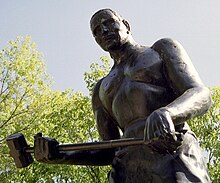John Henry (folk hero)
John Henry is a legendary American folk hero . Its historicity is controversial. The dates of his life are unknown (approx. 1840–1870).
Tradition tells the following story: As a released black man, John Henry worked as a railroad worker. According to other versions, he was a prisoner who was used for forced labor. It was his job as a "steel-driving man" ( Hauer ) to drive the blast holes for the tunnel construction for a new railway line in West Virginia into the rock . When one day this work was to be done by new steam-powered hammers, Henry offered to take up a competition with these novel rotary hammers. According to legend, John Henry won, but then collapsed dead. The railway line where Henry is said to have worked was then part of the Chesapeake and Ohio Railway and is now part of the Norfolk Southern Railway .
A plaque 37.65 ° N , 80.77 ° W and a statue 37.65 ° N , 80.77 ° are now located in front of the Big Bend Tunnel near Talcott , West Virginia, where the event is believed to have occurred W .
The story of John Henry has been implemented musically as a "Ballad by John Henry" with the inclusion of the "Take the Hammer" motif (e.g. by Johnny Cash , Pete Seeger , Joe Bonamassa , Van Morrison , Bruce Springsteen , Harry Belafonte , Jerry Lee Lewis , Leadbelly et al.). As a symbolic figure, John Henry is important in the American labor movement. Aaron Copland wrote a four-minute radio music for orchestra in 1940 .
See also
literature
- Johnson, Guy B. (1929) John Henry: Tracking Down a Negro Legend . Chapel Hill: University of North Carolina Press
- Chappell, Louis W. (1933) John Henry; A Folk-Lore Study . Reprinted 1968. Port Washington, NY: Kennikat Press
- Keats, Ezra Jack (1965) John Henry, An American Legend . New York: Pantheon Books.
- Williams, Brett (1983) John Henry: A Bio-Bibliography by Brett Williams. Westport, CT .: Greenwood Press
- Nelson, Scott. "Who Was John Henry? Railroad Construction, Southern Folklore, and the Birth of Rock and Roll," Labor: Studies in Working-Class History of the Americas Summer 2005 2: 53–80;
Web links
Individual evidence
- ^ "John Henry, Present at the Creation," Stephen Wade, NPR , September 2, 2002; Retrieved on: August 2, 2013 (English)
- ^ Cohen, Norm: Long steel rail: the railroad in American folksong ( English ). University of Illinois Press, Urbana 2000, ISBN 0-252-06881-5, (Retrieved August 3, 2013).
- ↑ Nelson, Scott Reynolds: Steel drivin 'man: John Henry, the untold story of an American legend ( English ). Oxford University Press, Oxford [Oxfordshire] 2006, ISBN 0-19-530010-6 .
- ↑ Botkin, BA: Treasury of American folklore: Stories, ballads, and traditions of the people. (PDF) Crown Publishers, October 1944, pp. 230-240 , archived from the original on March 27, 2012 ; accessed on April 28, 2016 .
- ↑ a b John Henry - The Story - Lewis Tunnel ( English ) Ibiblio.org. July 13, 2006. Retrieved July 20, 2010.
- ^ "Talcott prepares for John Henry Days," Sarah Plummer, The Register-Herald , June 28, 2010; Retrieved on: August 2, 2013 (English)
- ^ Dailycamera.com , Daily Camera , June 15, 2012; Retrieved on: August 2, 2013 (English)
- ^ John Garst: Chasing John Henry in Alabama and Mississippi: A Personal Memoir of Work in Progress . In: Tributaries: Journal of the Alabama Folklife Association . 5, 2002, pp. 92-129. Retrieved March 8, 2013.

